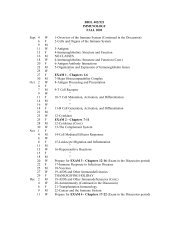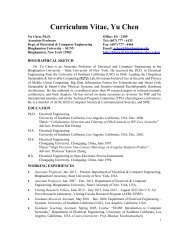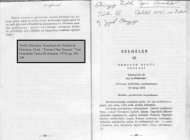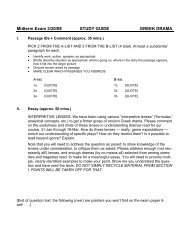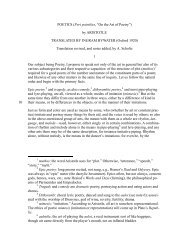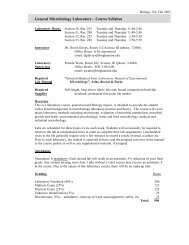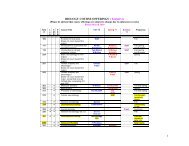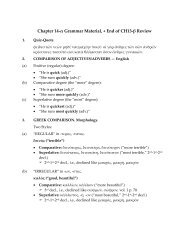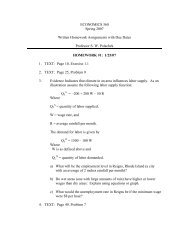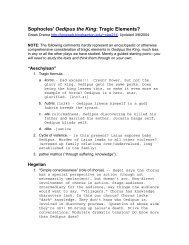Analysis of TCP CUBIC Using a Deterministic Loss Model - Harvey ...
Analysis of TCP CUBIC Using a Deterministic Loss Model - Harvey ...
Analysis of TCP CUBIC Using a Deterministic Loss Model - Harvey ...
Create successful ePaper yourself
Turn your PDF publications into a flip-book with our unique Google optimized e-Paper software.
A <strong>Deterministic</strong> <strong>Loss</strong> <strong>Model</strong> Based <strong>Analysis</strong> <strong>of</strong> <strong>CUBIC</strong>Rodolfo I. Ledesma Goyzueta, Yu ChenDepartment <strong>of</strong> Electrical and Computer Engineering, Binghamton University, Binghamton, NY 13902Email: {rledesm1, ychen}@binghamton.eduAbstract – Effective congestion control is one <strong>of</strong> the most criticalissues in the utility efficiency <strong>of</strong> network resources. Because <strong>of</strong>better scalability and higher flexibility, <strong>CUBIC</strong> has become awidely deployed <strong>TCP</strong> congestion control protocol in high-speedlong-delay networks and it is the current default algorithmimplemented in the Linux kernel. However, the behavior <strong>of</strong><strong>CUBIC</strong> is not fully understood. In this paper, a deterministicloss model has been proposed to analyze the characteristics <strong>of</strong>the concave region in the congestion avoidance state. This paperaims to provide deeper insight on the function and mechanism<strong>of</strong> <strong>CUBIC</strong> protocol. Through extensive mathematical analysisand simulation experimental study, this work verified that the<strong>CUBIC</strong> protocol effectively improved the bandwidth utilityefficiency in high-speed long-delay networks.Keywords: <strong>CUBIC</strong>, <strong>TCP</strong>, congestion control, Markov chain.1. IntroductionHigh-speed long-delay networks, also known as long fatnetworks, are characterized by a high bandwidth-delayproduct (BDP). BDP is the maximum amount <strong>of</strong> data that asender can send into the network before anyacknowledgement comes back from a receiver. It is also usedto evaluate the efficiency <strong>of</strong> bandwidth utility. Ideally, toachieve a 100% resource utility efficiency, the BDP tells theamount <strong>of</strong> data that a sender should keep within the network.However, in practice, network links are underutilizedand a lot <strong>of</strong> efforts have been reported to improve theefficiency. One <strong>of</strong> the obstacles that prevent the senders frominjecting more data packets into the network is the limitedcapabilities <strong>of</strong> congestion control protocols. In order to avoidcongestions that lead to packet dropping and re-transmission,senders are requested to start with small window size andincrease either additively or multiplicatively, behaving asspecified by such as additive-increase multiplicativedecrease(AIMD) or multiplicative-increase multiplicativedecrease(MIMD) model.Congestion control protocols (either AIMD, MIMD, orother derived protocols such as NewReno [1], [2], H<strong>TCP</strong> [3],HS<strong>TCP</strong> [4], S<strong>TCP</strong> [5]) reduce the sending window sizedrastically when packet dropping happens. Consequently, thenetwork throughput is also cut down significantly, and thelink remains underutilized for a period <strong>of</strong> time. After thewindow size cutting, recovery and congestion avoidance arecarried out by each protocol striving to occupy the link fully.Additionally, protocols generally also set a threshold <strong>of</strong>impending loss region.To achieve better link utilization, researchers haveproposed enhanced congestion control mechanisms such asFAST [6], Vegas [7], Westwood [8], BIC [9], and <strong>CUBIC</strong>[10]. Among them, <strong>CUBIC</strong> has been widely deployed inhigh-speed long-delay networks because <strong>of</strong> its betterscalability and higher flexibility. <strong>CUBIC</strong> is adopted by about45% <strong>of</strong> GNU/Linux servers [11], and currently it is thedefault algorithm implemented in the Linux kernel [12], [13].The stability <strong>of</strong> <strong>CUBIC</strong> lies in the fact that the flow hasa slow growth near the threshold’s neighborhood, betweenthe concave and convex regions. <strong>CUBIC</strong> also has a lowmultiplicative decrease parameter in comparison with othercongestion control protocols. Meanwhile, <strong>CUBIC</strong> protocolpossesses two important features. First, it follows a cubicgrowth function, and second, it was designed with a <strong>TCP</strong>friendlyregion.Although <strong>CUBIC</strong> has been accepted widely and itsoperation has impacted the performance <strong>of</strong> WANs [14], itsbehavior is not fully understood yet. While some researchershave tried to study the behavior <strong>of</strong> <strong>CUBIC</strong> through intensiveexperiments, it is still desired to analyze this protocol in amore precise and stricter way, mathematically.In this paper, we present an analytical model <strong>of</strong> <strong>CUBIC</strong>,particularly focusing on the concave region. Considering thewindow growth process as a random process, this model isderived using Markov chain. In addition, the window size,the round-trip time, and the number <strong>of</strong> packets before packetdropping happens are considered as variables involved in theMarkov chain’s states. Through extensive simulationexperiments we have verified our model.The remainder <strong>of</strong> this paper is organized as follows.Section 2 presents a brief review <strong>of</strong> related studies on<strong>CUBIC</strong>. Section 3 describes the principle and operation <strong>of</strong>the <strong>CUBIC</strong> window adjustment algorithm, includingdiscussions about both its growth function and itsparameters. In Section 4, a deterministic loss model isderived. Section 5 analyzes the mechanism <strong>of</strong> fastconvergence. Section 6 presents the results <strong>of</strong> the simulationexperiments. Section 7 wraps up this paper with somediscussion and conclusions.2. Related WorkThere are a lot <strong>of</strong> reported efforts in Internet congestioncontrol or congestion avoidance mechanisms. This sectionpresents a brief overview on studies that are closely related to<strong>CUBIC</strong>. Readers who are interested in this area are referredto more comprehensive surveys such as [15], [16].Leith et al. presented some experimental results for<strong>CUBIC</strong> [17]. The topology employed was dumbbelltopology. They tested some features <strong>of</strong> <strong>CUBIC</strong>, such as itsslow convergence and RTT fairness. However, someinformation and conclusions presented had led to a rebuttal
y Rhee, one <strong>of</strong> the designers <strong>of</strong> <strong>CUBIC</strong> [18]. In [19],Bateman et al. provided comprehensive comparison studythrough results obtained from both simulation and testbedemulation experiments. The behavior and performance <strong>of</strong><strong>CUBIC</strong> have been compared with multiple congestioncontrol schemes, such as <strong>TCP</strong> Reno with BIC, Scalable,HighSpeed, and Hamilton.<strong>Using</strong> FTP traffic traces, an analysis <strong>of</strong> performanceunder multiple scenarios is presented in [20]. The authorsused ns-2 and compared the performance <strong>of</strong> <strong>CUBIC</strong> withdifferent <strong>TCP</strong> algorithms such as <strong>TCP</strong> Reno, HS<strong>TCP</strong>, S<strong>TCP</strong>,and Compound <strong>TCP</strong>.In [21], an experimental evaluation <strong>of</strong> <strong>TCP</strong> <strong>CUBIC</strong> wasconducted. The implementation was on top <strong>of</strong> NetFPGAboard with small buffer setup. The authors’ motivation wasto project future network which might possess large capacityand small buffers. Recently, Bao et al. reported a slightlydifferent point <strong>of</strong> view from the above mentioned papers,modeling <strong>CUBIC</strong> over wireless networks [22]. The authorsderived a Markov chain model for performance analysis overwireless networks such as 3GPP, LTE, and WiMAX.The aforementioned papers presented some performanceresults. They did not provide more strict analysis or ananalytical model, except for [22]. However, the workreported in [22] was conducted in the context <strong>of</strong> wirelessnetworks. In this paper, our model focuses on wired, long fatnetwork environments.3. <strong>CUBIC</strong> Congestion ControlThis section presents a brief introduction to the <strong>CUBIC</strong>scheme. Basically, <strong>CUBIC</strong> employs ACK-clocking to adjustits window size [10], it does not change the fast recovery andfast retransmission algorithm adopted by <strong>TCP</strong> NewReno [2]and <strong>TCP</strong> SACK [23]. The window growth rate function <strong>of</strong><strong>CUBIC</strong> is shown in Figure 1, which displays the cubicfunction curve and its inflection point in W max (vertical axis).In case there is packet dropping event when thecongestion window size is W max , <strong>CUBIC</strong> starts work. It setsW max as the maximum window size. Then, <strong>CUBIC</strong> decreasesthe congestion window size multiplicatively with a rate .After that, <strong>CUBIC</strong> enters the congestion avoidance phase, inwhich its window growth procedure can be divided into threeregions, considering W max as reference value [10].<strong>CUBIC</strong> is allowed to maintain a slow growth near thelast maximum value, where packet dropping has occurred.Figure 1. <strong>CUBIC</strong> window growth function.The window adjustment function <strong>of</strong> <strong>CUBIC</strong> is [10]:W3( t)C(t K)Wmax (1)where C is a constant that determines the windowgrowth rate (aggressiveness) in high BDP networks, t is theelapsed time from the last packet dropping, and K is theestimated time period that would take to reach W max .Disregarding further packet loss, K is computed as follows:K 3.1 RegionsW3 maxCLet cwnd and W <strong>TCP</strong> (t) be the current congestion windowsize and standard <strong>TCP</strong> window size in a certain time,respectively. W <strong>TCP</strong> (t) is defined by standard <strong>TCP</strong> windowgrowth function. Then, <strong>CUBIC</strong> is within the <strong>TCP</strong>-friendlyregion if cwnd < W <strong>TCP</strong> (t). Thus, cwnd is set to W <strong>TCP</strong> (t) uponreceiving each ACK.If <strong>CUBIC</strong> is not in the <strong>TCP</strong>-friendly region and cwnd >W <strong>TCP</strong> (t), then, the protocol is in the concave region. In thisregion, cwnd increases following Eq. (1) until W max isreached. Once cwnd ≥ W max , the protocol is in the convexregion. The window growth function remains the same forboth concave and convex regions. As aforementioned, thegrowth rate is slow at the beginning near the W maxneighborhood.3.2 Fast Convergence<strong>CUBIC</strong> introduces a heuristic into the protocol toimprove convergence rate. This heuristic allows existing<strong>CUBIC</strong> flows to release (share) bandwidth to incomingflows. With this released bandwidth, incoming flows haveroom to grow. If the fast convergence mechanism is enabled,when a packet loss event occurs, the algorithm compares theprevious W max with the current W max . If the current W max isless than the previous W max , then it indicates that there arefewer available resources in the link. The algorithm belowexplains the heuristic:if (W_max < W_last_max){W_last_max = W_max;W_max = W_max*(2-)/2;} elseW_last_max = W_max;Here, W_max (integer) is the current maximum windowsize, W_last_max (integer) is the last maximum valueregistered, and is the multiplicative decrease factor.4. <strong>Deterministic</strong> <strong>Loss</strong> <strong>Model</strong>Assume the packet loss probability is p and the packetlosses are random and independent to each other. In addition,consider a long-lived <strong>CUBIC</strong> flow that operates in theconcave region <strong>of</strong> the congestion avoidance phase. To makeour mathematics easier, the model is simplified by(2)
Additionally, consider that packets travel on an availablelink for each flow and arrive to a queue as a Poisson processwith a mean throughput x. This parameter x depends on Eq.(13). Therefore,E[R]E[W ]x E[T ] RTT(14)5. <strong>Analysis</strong> <strong>of</strong> Fast ConvergenceThe fast convergence mechanism, as indicated inSection 3.2, adds heuristic in the protocol. In turn, fastconvergence provides room for incoming flows into thenetwork. Likewise, it is considered that all conditions are metto run the mechanism <strong>of</strong> fast convergence.However, the bandwidth release has a time limit. Whena flow suffers a packet loss event, it might be operating intwo modes: under fast convergence or not under fastconvergence. Then, after an elapsed time, the flow will reacha threshold where the window sizes <strong>of</strong> both modes are thesame. Beyond this threshold, the growth rate <strong>of</strong> the flow thatworks under fast convergence becomes more aggressive thanthe same flow if it had not used fast convergence.Consider K 1 and K 2 as estimated time periods using fastconvergence mode and not using it, respectively. 1 and 2are the reference maximum window sizes <strong>of</strong> the cubicfunctions using fast convergence mode and not using it,respectively. Thus, the time threshold may be calculated,knowing that at that point, the window sizes are equal:C( t K ) C(t K 331 12)2(15)Solving Eq. (15) gives the elapsed time to reach thethreshold, and in turn, we can obtain the time limit <strong>of</strong> fastconvergence. In this fashion,whereat2a 1 bt c 0b (Kc 1(3K121 K21) K K22 2 1 K2) 3C(K K )The Eq. (16) has the following unique solution: b b2 4act lim 2a21(16)(17)(18)The above result may be negligible if a packet loss eventoccurs or the data transmission concludes before the timelimit <strong>of</strong> fast convergence. Therefore, Eq. (18) is consideredas the time limit t lim , or duration <strong>of</strong> fast convergence.6. ValidationThis section validates the results <strong>of</strong> the analysis in theprevious sections. The mathematical analysis in previoussections allows obtaining theoretical results andunderstanding the characteristics <strong>of</strong> <strong>CUBIC</strong>.6.1 Behavior <strong>of</strong> <strong>CUBIC</strong>To analyze the influence <strong>of</strong> the periodic probability asshown by Eq. (13), two scenarios are considered. Figure 3compares the evolution <strong>of</strong> the average window size againstloss rate <strong>of</strong> <strong>CUBIC</strong>, <strong>TCP</strong> Reno, and Scalable <strong>TCP</strong>. Figure3(a) presents the average window size <strong>of</strong> a flow over a linkwith RTT=10 ms. Figure 3(b) displays the behavior <strong>of</strong> a flowover a link with RTT=100 ms. As shown in Figure 3(b), themean window size <strong>of</strong> <strong>CUBIC</strong> has less aggressive evolutionthan S<strong>TCP</strong> and <strong>TCP</strong> Reno. The first one is considerablyaggressive, whereas the second one has a more cautiousgrowth, but still amply aggressive.(a) RTT=10 ms.(b) RTT=100 ms.Figure 3. Validation <strong>of</strong> Eq. (13), with different RTT values.Figure 3(b) shows a better performance <strong>of</strong> <strong>CUBIC</strong>,which has a more aggressive growth in high-delay networks,S<strong>TCP</strong> is even more aggressive, but with less performancethan in low-delay networks. Furthermore, <strong>TCP</strong> Reno has thepoorest performance in high BDP networks, with high delay.This easily demonstrates the lack <strong>of</strong> fairness <strong>of</strong> both S<strong>TCP</strong>and <strong>TCP</strong> Reno flows on high-delay links.The parameter C is a constant defined by <strong>CUBIC</strong> anddenotes the window growth rate aggressiveness [10]. Wecompared the network response against different values <strong>of</strong> C.Figure 4 displays a better performance for <strong>CUBIC</strong> in highdelaynetworks when RTT=10 ms and 100ms respectively.(a) RTT=10 ms.(b) RTT=100 ms.Figure 4. Impact <strong>of</strong> parameter C.Figure 5 illustrates the relationship between theparameters K and C through different values <strong>of</strong> packet loss



